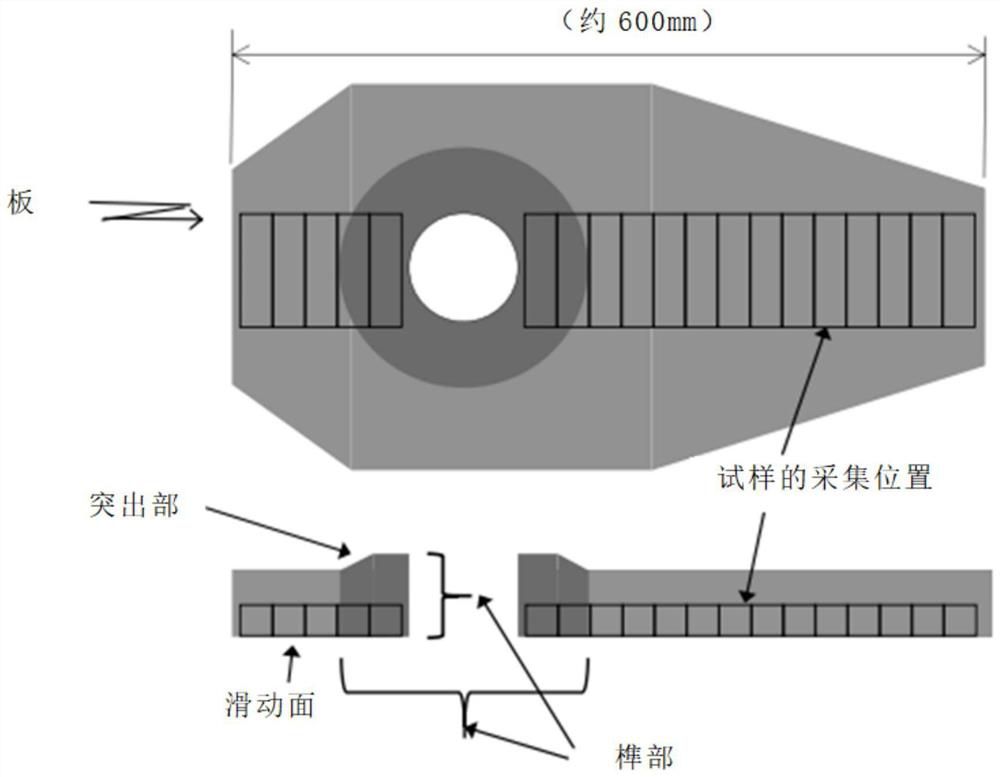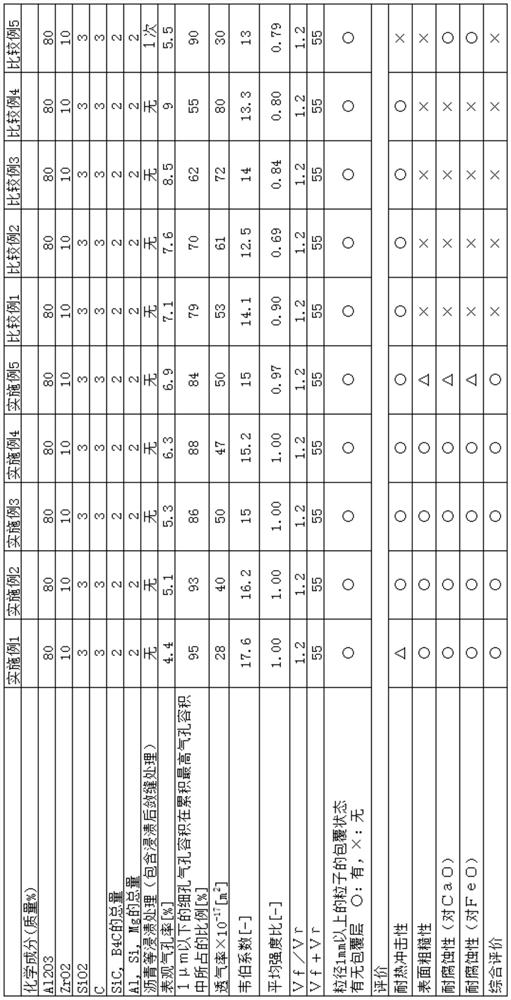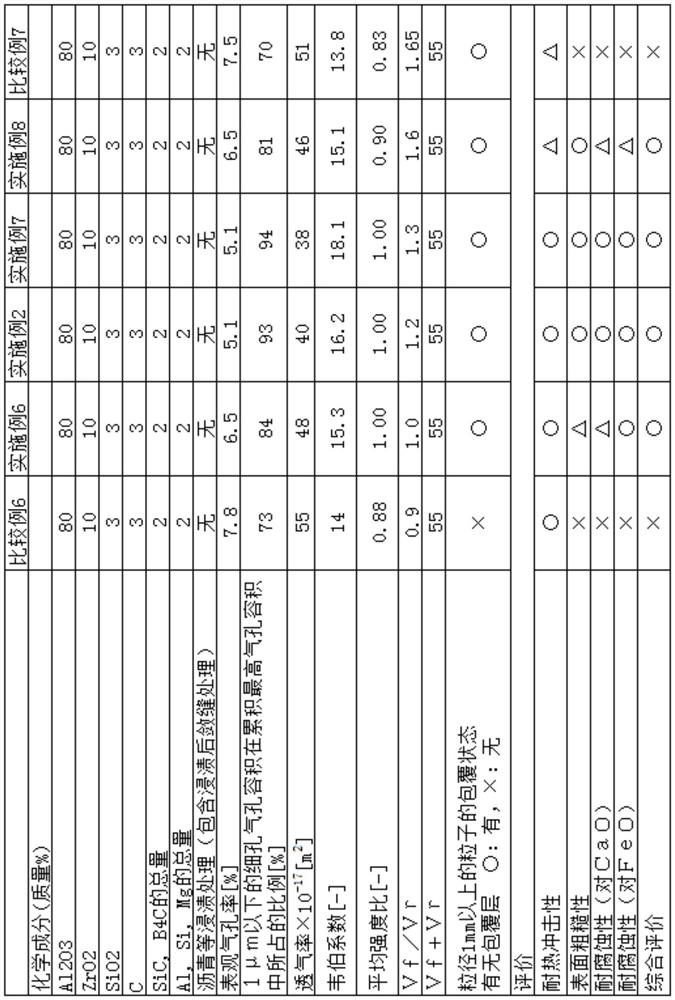Refractory material
A refractory material and raw material technology, applied in the field of refractory materials, can solve problems such as flow control obstruction, steel breakout, chemical damage, etc., achieve high corrosion resistance and thermal shock resistance, suppress the increase in manufacturing costs, and shorten the manufacturing cycle. Effect
- Summary
- Abstract
- Description
- Claims
- Application Information
AI Technical Summary
Problems solved by technology
Method used
Image
Examples
Embodiment A
[0102] Example A is an example in which influences on thermal shock resistance, surface roughness, corrosion resistance, etc. were investigated by changing the apparent porosity, the ratio of the pore volume of pores having a pore diameter of 1 μm or less, and the air permeability.
[0103] The raw material of the refractory material of this example A is the most common Al 2 O 3 class, the main body is an artificial particle composed of corundum, which is Al 2 O 3 -ZrO 2 Mass particles, SiC and B4C powder, metal Al powder, the total volume ratio of (Vf / Vr) obtained by the above-mentioned method is 1.0 or more and 1.6 or less, and the total volume ratio of (Vf+Vr) obtained by the method is 50 In the range of volume % or more and 80 volume % or less, the kneaded clay for forming was adjusted to substantially the same value in all the examples.
[0104] The same applies to Examples B to D to be described later.
[0105] In addition, in Tables 1 to 4, the chemical components ...
Embodiment B
[0125] Example B is an example in which influences on thermal shock resistance, surface roughness, corrosion resistance, and the like were investigated by changing the apparent porosity and the ratio of the pore volume of pores having a pore diameter of 1 μm or less.
[0126] In addition, each example in this Example B was obtained by adjusting the above-mentioned (Vf / Vr).
[0127] Table 2 shows the constitution and results of each example.
[0128] (Table 2)
[0129]
[0130] It was found that the apparent porosity, the ratio of the pore volume of pores having a pore diameter of 1 μm or less, and the air permeability also changed with the change of (Vf / Vr). In all the examples in which (Vf / Vr) satisfies 1.0 or more and 1.6 or less, the thermal shock resistance, surface roughness, corrosion resistance (to FeO), and corrosion resistance (to CaO) are all acceptable (evaluated as 0 (excellent). ) or Δ (good)) or better results than the impregnated product, that is, Comparati...
Embodiment C
[0133] Example C is an example in which influences on thermal shock resistance, surface roughness, corrosion resistance, and the like were investigated by changing the apparent porosity and air permeability.
[0134] In addition, each example in this Example C was obtained by adjusting the above-mentioned (Vf+Vr).
[0135] Table 3 shows the constitution and results of each example.
[0136] (table 3)
[0137]
[0138] It can be seen that the air permeability changes as (Vf+Vr) changes. In all the examples in which (Vf+Vr) satisfies 50 or more and 80 or less, thermal shock resistance, surface roughness, corrosion resistance (to FeO), and corrosion resistance (to CaO) are all acceptable (evaluated as 0 (excellent). ) or Δ (good)) or better results than the impregnated product, that is, Comparative Example 5 (Table 1).
[0139] On the other hand, in Comparative Example 8, Comparative Example 9, and Comparative Example 10 in which (Vf+Vr) was not within the range of the pres...
PUM
 Login to View More
Login to View More Abstract
Description
Claims
Application Information
 Login to View More
Login to View More - R&D
- Intellectual Property
- Life Sciences
- Materials
- Tech Scout
- Unparalleled Data Quality
- Higher Quality Content
- 60% Fewer Hallucinations
Browse by: Latest US Patents, China's latest patents, Technical Efficacy Thesaurus, Application Domain, Technology Topic, Popular Technical Reports.
© 2025 PatSnap. All rights reserved.Legal|Privacy policy|Modern Slavery Act Transparency Statement|Sitemap|About US| Contact US: help@patsnap.com



